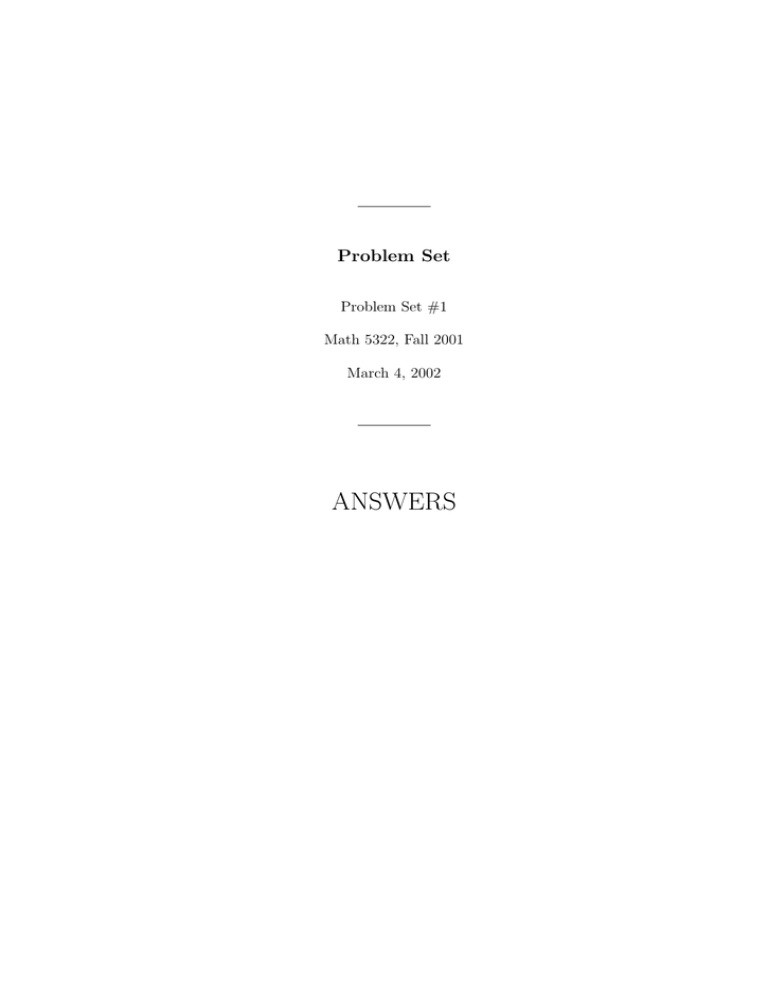ANSWERS Problem Set Problem Set #1 Math 5322, Fall 2001
advertisement

Problem Set
Problem Set #1
Math 5322, Fall 2001
March 4, 2002
ANSWERS
i
All of the problems are from Chapter 3 of the text.
Problem 1. [Problem 2, page 88]
If ν is a signed measure, E is ν-null iff |ν|(E) = 0. Also, if ν and µ are
signed measures, ν ⊥ µ iff |ν| ⊥ µ iff ν + ⊥ µ and ν − ⊥ µ
Answer :
For the first part of the problem, let X = P ∪ N be a Hahn decomposition of
X with respect to ν. Thus, we have
ν + (E) = ν(E ∩ P )
ν − (E) = −ν(E ∩ N )
|ν| = ν + + ν −
Assume that E is ν-null. This means that for all measurable F ⊆ E, ν(F ) = 0.
But then E ∩ P ⊆ E, so ν + (E) = 0 and E ∩ N ⊆ E, so ν − (E) = 0. Then we
have |ν|(E) = ν + (E) + ν − (E) = 0
Conversely, suppose that |ν|(E) = 0. Let F ⊆ E be measurable. Then
0 ≤ ν + (F ) + ν − (F ) = |ν|(F ) ≤ |ν|(E) = 0, so ν + (F ) = 0 and ν − (F ) = 0. But
then ν(F ) = ν + (F ) − ν − (F ) = 0. Thus, we can conclude that E is ν-null.
For the second part of the problem, we want to show that the following
conditions are equivalent.
(1) ν ⊥ µ
(2) ν + ⊥ µ and ν − ⊥ µ
(3) |ν| ⊥ µ
Let’s first show that (1) =⇒ (2). Since ν ⊥ µ, we can decompose X into a
disjoint union of measurable sets A and B so that A is µ-null and B is ν-null.
We can also find an Hahn decomposition X = P ∪N with respect to ν, as above.
Since B in ν-null, we have ν + (B) = ν(P ∩ B) = 0 and ν − (B) = −ν(B ∩ N ) = 0.
Thus, B is ν + -null and ν − -null. Since A is still µ-null, we conclude that ν + ⊥ µ
and ν − ⊥ µ.
Next, we show that (2) =⇒ (3). Since ν + ⊥ µ, we can find disjoint
measurable sets A1 and B1 so that X = A1 ∪ B1 , ν + (B1 ) = 0 and A1 is µ-null.
Similarly, we can write X = A2 ∪ B2 (disjoint union) where ν − (B2 ) = 0 and A2
is µ-null. We can then partition X as
X = (A1 ∩ A2 ) ∪ (A1 ∩ B2 ) ∪ (A2 ∩ B1 ) ∪ (B1 ∩ B2 )
Now, (A1 ∩ A2 ) is contained in the µ-null set A1 , and so is µ-null. Similarly,
A2 ∩ B2 and A2 ∩ B1 are µ-null. We have 0 ≤ ν + (B1 ∩ B2 ) ≤ ν + (B1 ) = 0, so
ν + (B1 ∩ B2 ) = 0. Similarly, ν − (B1 ∩ B2 ) = 0, and thus |ν|(B1 ∩ B2 ) = 0. We
thus have a disjoint measurable decomposition X = A3 ∪ B3 where
A3 = (A1 ∩ A2 ) ∪ (A1 ∩ B2 ) ∪ (A2 ∩ B1 )
B3 = B1 ∩ B2 .
1
The set A3 is µ-null and B3 is |ν|-null. This shows that |ν| ⊥ µ.
Finally we show that (3) =⇒ (1). So, suppose that |ν| ⊥ µ. The we have
a measurable decomposition X = A ∪ B where |ν|(B) = 0 and A is µ-null.
However, |ν|(B) = 0 implies that B is ν-null (as we proved above), so we have
ν ⊥ µ.
Problem 2. [Problem 3, page 88]
Let ν be a signed measure on (X, M).
a. L1 (ν) = L1 (|ν|).
b. If f ∈ L1 (ν),
Z
Z
f dν ≤ |f | d|ν|.
c. If E ∈ M,
Z
|ν|(E) = sup f dν | |f | ≤ 1
E
Answer :
According to the definition on page 88 of the text, the definition of L1 (ν) is
L1 (ν) = L1 (ν + ) ∩ L1 (ν − ) and if f ∈ L1 (ν), we define
Z
Z
Z
f dν = f dν + − f dν − .
So, consider part (a.) of the problem. If f ∈ L1 (ν), then, by definition the
integrals
Z
Z
(∗)
|f | dν + ,
|f | dν −
are finite. On the other hand, |ν| is defined by |ν|(E) = ν + (E) + ν − (E). Hence,
the equation
Z
Z
Z
χE d|ν| =
χE dν + +
χE dν −
holds by definition. Thus, we can apply the usual argument to show that
Z
Z
Z
(∗∗)
g d|ν| = g dν + + g dν −
holds for all measurable g : X → [0, ∞]: This equations holds for characteristic
functions, hence (by linearity) for simple functions and hence (by the monotone
convergence theorem) Rfor nonnegative functions. Thus, if the integrals in (∗)
are finite, the integral |f | d|ν| is finite, soRf ∈ L1 (|ν|).
Conversely, if f ∈ L1 (|ν|), the integral |f | d|ν| is finite, and so by (∗∗), the
integrals in (∗) are finite, so f ∈ L1 (ν).
2
Next consider part (b.) of the problem. If f ∈ L1 (ν), then by definition
Z
Z
Z
Z
Z
Z
Z
f dν = f dν + − f dν − = f + dν + − f − dν + − f + dν − + f − dν − ,
where all of the integrals on the right are positive numbers. Hence, by the
triangle inequality,
Z
Z
Z
Z
Z
f dν ≤ f + dν + + f − dν + + f + dν − + f − dν −
Z
Z
= (f + + f − ) dν + + (f + + f − ) dν −
Z
Z
= |f | dν + + |f | dν −
Z
= |f | d|ν|
Finally, consider part (c.) of the problem. If |f | ≤ 1, then for any E ∈ M,
|f |χE ≤ χE . Thus, we have
Z
Z
f dν ≤
|f | d|ν|
E
E
Z
=
|f |χE d|ν|
ZX
≤
χE d|ν|
X
= |ν|(E).
Thus, the sup in part (c.) is ≤ |ν|(E).
To get the reverse inequality, let X = P ∪ N be a Hahn decomposition of X
with respect to ν, and recall the description of ν + and ν − in terms of P and N
from the last problem. Then we have
Z
|ν|(E) = ν(E ∩ P ) − ν(E ∩ N ) = (χE∩P − χE∩N ) dν.
But, |χE∩P − χE∩N | ≤ 1 (P and N are disjoint). This shows that |ν|(E) is an
element of the set we’re supping over, so |ν|(E) ≤ the sup.
Problem 3. [Problem 4, page 88]
If ν is a signed measure and λ, µ are positive measures such that ν = λ − µ,
then λ ≥ ν + and µ ≥ ν − .
Answer :
Let X = P ∪ N be a Hahn decomposition of X with respect to ν. Then for any
measurable set E, we have
(∗)
ν + (E) = ν(E ∩ P ) = λ(E ∩ P ) − µ(E ∩ P ).
3
If ν + (E) = ∞, this equation shows λ(E ∩ P ) = ∞, and so λ(E) = ∞. Thus,
ν + (E) ≥ λ(E) is true in this case. If ν + (E) < ∞, then both numbers on the
right of (∗) must be finite, and (∗) gives ν + (E) + µ(E ∩ P ) = λ(E ∩ P ). Thus,
we have
ν + (E) ≤ ν + (E) + µ(E ∩ P ) = λ(E ∩ P ) ≤ λ(E).
The argument for the other inequality is similar. We have
ν − (E) = −ν(E ∩ N ) = −λ(E ∩ N ) + µ(E ∩ N )
If ν − (E) = ∞, then we must have µ(E) ≥ µ(E ∩ N ) = ∞, so µ(E) ≥ ν − (E).
Otherwise, every thing must be finite and
ν − (E) ≤ ν − (E) + λ(E ∩ N ) = µ(E ∩ N ) ≤ µ(E).
Problem 4. [Problem 5, page 88] If ν1 and ν2 are signed measures that
both omitted the value +∞ or −∞, then |ν1 + ν2 | ≤ |ν1 | + |ν2 |.
(Use Exercise 4.)
Answer :
The hypothesis that ±∞ is omitted assures that the signed measure ν1 + ν2 is
defined.
We have v1 = ν1+ − ν1− and ν2 = ν2+ − ν2− . Adding these equations gives
ν1 + ν2 = (ν1+ + ν2+ ) − (ν1− + ν2− ),
where the expressions in parentheses are positive measures. Thus, by Exercise 4,
we have
(ν1 + ν2 )+ ≤ ν1+ + ν2+
(ν1 + ν2 )− ≤ ν1− + ν2−
and adding these inequalities gives |ν1 + ν2 | ≤ |ν1 | + |ν2 |.
Problem 5. [Problem 12, page 92]
For j = 1, 2, let µj , νj be σ-finite measures on (Xj , Mj ) such that νj µj .
then ν1 × ν2 µ1 × µ2 and
d(ν1 × ν2 )
dν1
dν2
(x1 , x2 ) =
(x1 )
(x2 ).
d(µ1 × µ2 )
dµ1
dµ2
Answer :
We first want to show that ν1 × ν2 µ1 × µ2 . So, suppose that E ∈ M1 ⊗ M2
and (µ1 × µ2 )(E) = 0. Recall that the x1 -section of E is defined by
Ex1 = { x2 ∈ X2 | (x1 , x2 ) ∈ E } .
4
By Theorem 2.36 on page 66 of the text, the function x1 7→ µ2 (Ex1 ) is measurable and
Z
0 = (µ1 × µ2 )(E) =
µ2 (Ex1 ) dµ1 (x1 )
X1
Thus, µ2 (Ex1 ) = 0 for µ1 -almost all x1 . In other words, there is a µ1 -null set
N ⊆ X1 so that µ2 (Ex1 ) = 0 if x1 ∈
/ N . If x1 ∈
/ N , we must have ν2 (Ex1 ) = 0,
since ν2 µ2 . We also have ν1 (N ) = 0, since ν1 µ1 . Thus, x1 7→ ν2 (Ex1 ) is
zero almost everywhere with respect to ν1 . Thus, we have
Z
(ν1 × ν2 )(E) =
ν2 (Ex1 ) dν1 (x1 ) = 0.
X1
Thus, (µ1 × µ2 )(E) = 0 =⇒ (ν1 × ν2 )(E) = 0, so ν1 × ν2 µ1 × µ2 .
For notational simplicity, let
f=
d(ν1 × ν2 )
,
d(µ1 × µ2 )
f1 =
dν1
,
dµ1
f2 =
dν2
.
dµ2
The, we have
Z
(∗)
(ν1 × ν2 )(E) =
f (x1 , x2 ) d(µ1 × µ2 )(x1 , x2 )
E
and f is the unique (up to equality almost everywhere) function with this property. Of course we have
Z
ν1 (A) =
f1 (x1 ) dµ1 (x1 )
ZA
ν2 (B) =
f2 (x2 ) dµ2 (x2 )
B
if A ⊆ X1 and B ⊆ X2 are measurable.
On the other hand, the functions (x1 , x2 ) 7→ f1 (x1 ) and (x1 , x2 ) 7→ f2 (x2 )
are measurable, so we can define a measure λ on X1 × X2 by
Z
(∗∗)
λ(E) =
f1 (x1 )f2 (x2 ) d(µ1 × µ2 )(x1 , x2 ).
E
Suppose that A1 ⊆ X1 and A2 ⊆ X2 . Then, we can use Tonelli’s Theorem to
5
calculate λ(A1 × A2 ) as follows:
Z
λ(A1 × A2 ) =
f1 (x1 )f2 (x2 ) d(µ1 × µ2 )(x1 , x2 )
A ×A
Z 1 2
=
χA1 ×A2 (x1 , x2 )f1 (x1 )f2 (x2 ) d(µ1 × µ2 )(x1 , x2 )
ZX1 ×X2
=
χA1 (x1 )χA2 (x2 )f1 (x1 )f2 (x2 ) d(µ1 × µ2 )(x1 , x2 )
ZX1 ×X
Z 2
=
χA1 (x1 )χA2 (x2 )f1 (x1 )f2 (x2 ) dµ2 (x2 ) dµ1 (x1 )
ZX1 X2
Z
=
χA1 (x1 )f1 (x1 )
χA2 (x2 )f2 (x2 ) dµ2 (x2 ) dµ1 (x1 )
X1
X2
Z
=
χA1 (x1 )f1 (x1 )ν2 (A2 ) dµ1 (x1 )
X1
Z
= ν2 (A2 )
χA1 (x1 )f1 (x1 ) dµ1 (x1 )
X1
= ν1 (A1 )ν2 (A2 ).
Thus we have
λ(A1 × A2 ) = ν1 (A1 )ν2 (A2 ) = (ν1 × ν2 )(A1 × A2 ).
for all measurable rectangles A1 × A2 . Since our measures are σ-finite, this
shows that λ = ν1 × ν2 , see the remark at the bottom of page 64 in the
text. Comparing (∗) and (∗∗) and using the uniqueness in (∗) then shows
that f (x1 , x2 ) = f1 (x1 )f2 (x2 )
Problem 6. [Problem 16, page 92] Suppose that µ, ν are measures on
(X, M) with ν µ and let λ = µ + ν. If f = dν/dλ, then
0 ≤ f < 1 µ-a.e. and dν/dµ = f /(1 − f ).
Answer :
It’s clear that ν λ, so f = dν/dλ makes sense.
We want to show 0 ≤ f < 1 µ-a.e. Suppose, for a contradiction, that
the is a set E with µ(E) > 0 and f ≥ 1 on E. On the on hand, we have
ν(E) < ν(E) + µ(E) = λ(E). On the other hand, f χE ≥ χE , so
Z
Z
Z
ν(E) =
f dλ = χE f dλ ≥ χE dλ = λ(E),
E
a contradiction.
If E is measurable, we have
Z
Z
Z
Z
1 dν = ν(E) =
f dλ =
f dµ +
f dν,
E
E
E
6
E
which yields
Z
Z
(1 − f ) dν =
E
f dµ,
E
or, in other words,
Z
Z
χE (1 − f ) dν =
χE f dµ.
By the usual procedure, we can extend this equation from characteristic functions to nonnegative functions. Thus, we have
Z
Z
g(1 − f ) dν = gf dµ
for all nonnegative measurable functions g. Hence, for any measurable set E,
we have
Z
Z
(∗)
g(1 − f ) dν =
gf dµ
E
E
for all nonnegative measurable functions g.
Since 0 ≤ f < 1 µ-a.e. the function 1/(1 − f ) is defined and nonnegative
µ-a.e. Since ν µ, 1/(1 − f ) is also defined and nonnegative ν-a.e. Thus, we
can set g = 1/(1 − f ) in (∗). This gives
Z
f
dµ,
ν(E) =
1
−
f
E
for all measurable E, whence dν/dµ = f /(1 − f ).
Problem 7. [Problem 18, page 94] Prove Proposition 3.13c.
In other words, suppose that ν is a complex measure on (X, M). Then
L1 (ν) = L1 (|ν|) and if f ∈ L1 (ν),
Z
Z
f dν ≤ |f | d|ν|.
Answer :
I seem to have been very confused the day I tried to do this in class!
Let z = x + iy be a complex number, where x, y are real. We have
x2 , y 2 ≤ x2 + y 2 = |z|2
so taking square roots gives |x|, |y| ≤ |z|. One the other hand, we have
|z|2 = x2 + y 2 = |x|2 + |y|2 ≤ |x|2 + 2|x||y| + |y|2 = [|x| + |y|]2 ,
and so |z| ≤ |x| + |y|.
7
Now lets begin the solution of the problem. By the definition on page 93 of
the text, L1 (ν) is defined to be L1 (νr ) ∩ L1 (νi ) and for f ∈ L1 (ν), we define
Z
Z
Z
f dν = f dνr + i f dνi .
On the other hand, we know from Exercise 3 on page 88 of the text (one of
the problems in this set) that for a signed measure λ, L1 (λ) = L1 (|λ|) and for
f ∈ L1 (λ),
Z
Z
f dλ ≤ |f | d|λ|.
Hence in our present situation, we know L1 (ν) = L1 (|νr |) ∩ L1 (|νi |).
Let’s recall the reasoning of part b. of Proposition 3.13. We can find some
finite positive measure µ such that νr and νi are absolutely continuous with
respect to µ (µ = |νr | + |νi | will do). Then, by the Lebesgue-Radon-Nikodym
Theorem, there are real-valued measurable functions f and g such that dνr =
f dµ and dνi = g dµ. Then, we have
Z
(∗)
ν(E) =
h dµ
E
where h = f + ig. From this equation, we have d|ν| = |h| dµ, by definition.
Since |f |, |g| ≤ |h| we have
Z
Z
|νr |(E) =
|f | dµ ≤
|h| dµ = |ν|(E)
ZE
ZE
|νi |(E) =
|g| dµ ≤
|h| dµ = |ν|(E)
E
E
so we certainly have νr , νi |ν|. Thus, once again, we can find real-valued
functions ϕ and η such that dνr = ϕ d|ν| and dνi = η d|ν|. If ϕ = ψ + iη, then
Z
ν(E) =
ϕ d|ν|.
E
But then, comparing with (∗), we have
Z
Z
ϕ|h| dµ =
h dµ.
E
E
By the uniqueness part of the Lebesgue-Radon-Nikodym Theorem, ϕ|h| = h,
µ-a.e., and hence |ν|-a.e. On the other hand if Z is the set where h = 0, then
Z
Z
|ν|(Z) = |h| dµ =
0 dµ = 0
Z
Z
so h 6= 0, |ν|-a.e. This shows that |ϕ| = 1, |ν|-a.e., so we can conclude that
|ψ|, |η| ≤ |ϕ| = 1, |ν|-a.e., and 1 = |ϕ| ≤ |ψ| + |η|, |ν|-a.e. Finally, we have
d|νr | = |ψ| d|ν| and d|νi | = |η| d|ν|.
8
Now, suppose that f ∈ L1 (|ν|). Then
Z
|f | d|ν| < ∞
Since |f ||ψ| ≤ |f |, |ν|-a.e., we have
Z
Z
|f ||ψ| d|ν| ≤ |f | d|ν| < ∞
but the integral on the left is
Z
|f | d|νr |,
so f ∈ L1 (|νr |). Similarly, f ∈ L1 (|νi |)
Conversely, suppose that f ∈ L1 (|νr |) ∩ L1 (|νi |) Then we have
Z
Z
|f ||ψ| d|ν| = |f | d|νr | < ∞
Z
Z
|f ||η| d|ν| = |f | d|νi | < ∞.
and so we have
Z
|f |[|ψ| + |η|] d|ν| < ∞.
However, we have 1 ≤ |ψ| + |η|, |ν|-a.e., so
Z
Z
|f | d|ν| ≤ |f |[|ψ| + |η|] d|ν| < ∞.
and so f ∈ L1 (|ν|).
Finally, suppose that f ∈ L1 (ν) = L1 (|ν|), we then have
Z
Z
Z
f dν = f dνr + i f dνi by definition
Z
Z
= f ψ d|ν| + i f η d|ν|
Z
= f [ψ + iη] d|ν|
Z
= f ϕ d|ν|
Z
≤ |f ||ϕ| d|ν|
Z
= |f | d|ν|,
since |ϕ| = 1, |ν|-a.e. This completes the proof.
9
Problem 8. [Problem 20, page 94] If ν is a complex measure on (X, M)
and ν(X) = |ν|(X), then ν = |ν|.
Answer :
Let f = dν/d|ν|, so we have
Z
(∗)
ν(E) =
f d|ν|
E
for all measurable sets E, and we know from Proposition 3.13 on page 94 of the
text that |f | = 1 |ν|-a.e. We may as well suppose that |f | = 1 everywhere.
We can write the complex function f as f = g + ih, where g and h are
real-valued. We can also write ν = νr + iνi for finite signed measures νr and νi .
Thus, we have
Z
Z
Z
νr (E) + iνi (E) = ν(E) =
f d|ν| =
g d|ν| + i
h d|ν|.
E
E
E
Comparing real and imaginary parts, we get
Z
νr (E) =
g d|ν|
ZE
νi (E) =
h d|ν|.
E
By hypothesis, we have ν(X) = |ν|(X), so
Z
Z
g d|ν| + i
h d|ν| = |ν|(X).
X
X
Since the right-hand side is real, the imaginary part of the left-hand side must
be zero, and we have
Z
Z
g d|ν| = |ν|(X) =
1 d|ν|,
X
X
and so
Z
(∗∗)
(1 − g) d|ν|.
0=
X
Since g is the real part of f , we have
g ≤ |g| ≤ |g + ih| = |f | = 1
so 1 − g ≥ 0. But then (∗∗) shows that 1 − g = 0 a.e., so g = 1 a.e.
We then have 1 = |f |2 = g 2 + h2 = 1 + h2 a.e., so h = 0 a.e. and hence
f = g = 1 a.e. Putting this in (∗) shows that ν = |ν|.
10
Problem 9. [Problem 20, page 94] Let ν be a complex measure on (X, M).
If E ∈ M, define
n
n
X
[
(A) µ1 (E) = sup
|ν(Ej )| | n ∈ N, E1 , . . . , En disjoint, E =
Ej ,
j=1
j=1
∞
∞
X
[
(B) µ2 (E) = sup
|ν(Ej )| | E1 , E2 , . . . disjoint, E =
Ej ,
j=1
j=1
Z
(C) µ3 (E) = sup f dν | |f | ≤ 1 .
E
Then µ1 = µ2 = µ3 = |ν|.
Answer :
Although the author didn’t explicitly say so, the sets Ej in (A) and (B) should,
of course, be measurable and the functions f in (C) should be measurable. Also
note that the book has a typo in (C) ( dµ instead of dν).
As suggested in the book, we first prove that µ1 ≤ µ2 ≤ µ3 ≤ µ1 and then
that µ3 = |ν|.
We have µ1 ≤ µ2 , because the sums in (A) are among the sums in (B): given
a finite sequence E1 , . . . , En of disjoint sets whose union is E, just set Ej = ∅
for j > n. Then E1 , E2 , . . . is an infinite sequence of disjoint sets whose union
is E and
n
∞
X
X
|ν(Ej )| =
|ν(Ej )|.
j=1
j=1
Thus, the set of numbers in (A) is a subset of the set of numbers in (B). Since
the sup over a larger set is larger, µ1 ≤ µ2 .
To see that µ2 ≤ µ3 , let E1 , E2 , . . . be a sequence of disjoint sets whose
union is E. Now each ν(Ej ) is a complex number, so there is a complex number
ωj such that |ωj | = 1 and ωj ν(Ej ) = |ν(Ej )|. Indeed, we can say
( |ν(E )|
j
, ν(Ej ) 6= 0
ωj = ν(Ej )
1,
ν(Ej ) = 0.
Consider the function f defined by
f=
∞
X
ωj χEj .
j=1
If x ∈
/ E, f (x) = 0. If x ∈ E, it is in exactly one Ej and then |f (x)| = |ωj | = 1.
Thus, |f | ≤ 1 and the partial sums
fn =
n
X
j=1
11
ωj χEj
satisfy |fn | ≤ 1 by the same reasoning. We then have
Z
Z
Z
Z
fn dν − f dν = (fn − f ) dν ≤ |fn − f | d|ν| → 0
by the dominated convergence theorem, since fn → f pointwise and |fn − f | is
bounded above by the constant function 2, which is integrable with respect to
the finite measure |ν|. We then have
Z
Z
f dν = lim
fn dν
n→∞
E
=
=
=
∞ Z
X
j=1
∞
X
j=1
∞
X
ωj χEj dν
E
ωj ν(Ej )
|ν(Ej )|.
j=1
since
R
E
f dν is positive, we have
Z
∞
X
f dν =
|ν(Ej )|.
E
j=1
Thus, the set of numbers in (B) is a subset of the set in (C), so µ2 ≤ µ3 .
Now we want to show that µ3 ≤ µ1 . First, we use Proposition 3.13 (and
Exercise 18) to show that µ3 is finite. If |f | ≤ 1, then
Z
Z
|f | d|ν| ≤ 1 d|ν| = |ν|(X) < ∞,
so f ∈ L1 (|ν|) = L1 (ν) and
Z
Z
Z
f dν ≤
|f | d|ν| ≤
1 d|ν| = |ν|(E).
E
E
E
Thus, |ν|(E) is an upper bound for the set of numbers in (C), so µ3 (E) ≤
|ν|(E) ≤ |ν|(X) < ∞.
To show that µ3 ≤ µ1 , let ε > 0 be given. Then we can find some f with
|f | ≤ 1 such that
Z
µ3 (E) − ε < f dν ,
E
which implies
(∗)
Z
µ3 (E) ≤ f dν + ε.
E
12
We approximate f by a simple function as follows. Let
D = { z ∈ C | |z| ≤ 1 }
be the closed unit disk in the complex plane. Since |f | ≤ 1, all the values of f
are in D. The collection of balls
{ B(ε, z) | z ∈ D }
is an open cover of D. Since D is compact, there is a finite subcover, say
{ B(ε, zj ) | j = 1, . . . , m } .
Define Bj = f −1 (B(ε, zj )) ⊆ X, which is measurable since f is measurable. The
union of the sets Bj is X. The sets Bj won’t be disjoint, but we can use the
usual trick and define
A1 = B1 ,
Aj = Bj \
j−1
[
Bk
k=1
to get a disjoint collection of sets with Aj ⊆ Bj and
function ϕ by
m
X
ϕ=
zj χAj .
S
j
Aj = X. Define a simple
j=1
This function takes on the values zj , which are in D, so |ϕ| ≤ 1. If x ∈ X it is
in exactly one of the sets Aj . But then f (x) ∈ B(ε, zj ), so
|f (x) − ϕ(x)| = |f (x) − zj | < ε.
Thus, |f − ϕ| < ε. We then have
Z
Z
Z
Z
f dν − ϕ dν ≤ f dν − ϕ dν E
E
E
Z E
Z
≤
f dν −
ϕ dν E
ZE
≤
|f − ϕ| d|ν|
ZE
≤
ε d|ν|
E
= ε|ν|(E).
Thus, we have
Z
Z
f dν ≤ ϕ dν + ε|ν|(E).
E
E
13
Substituting this is (∗) gives
(∗∗)
Z
µ3 (E) ≤ ϕ dν + ε + ε|ν|(E).
E
Now define Ej = Aj ∩ E, j = 1, . . . , m. Then the Ej ’s are a finite sequence
of disjoint sets whose union is E and we have
Z
Z X
m
ϕ dν = z
χ
j Aj dν E
E j=1
X
Z
m
=
zj
χAj dν j=1
E
m
Z
X
=
zj χE χAj dν j=1
m
Z
X
= zj χEj dν j=1
m
X
=
zj ν(Ej )
j=1
≤
≤
m
X
j=1
m
X
|zj ||ν(Ej )|
|ν(Ej )|
j=1
≤ µ1 (E).
Substituting this into (∗∗) gives
µ3 (E) ≤ µ1 (E) + [1 + |ν|(E)]ε.
Since ε > 0 was arbitrary, we conclude that µ3 (E) ≤ µ1 (E).
We’ve now shown that µ1 = µ2 = µ3 . The last step is to show that µ3 = |ν|.
We’ve already shown above that µ3 (E) ≤ |ν|(E). To get the reverse inequality,
let g = dν/d|ν|. We know that |g| = 1 |ν|-a.e., and we may as well assume
that |g| = 1 everywhere (by modifying it on a set of measure zero). Then the
conjugate ḡ of g satisfies |ḡ| = 1 ≤ 1 and so is one of the functions in the
definition of µ3 , so
Z
ḡ dν ≤ µ3 (E).
E
14
But, from the definition of g,
Z
Z
ḡ dν = ḡg d|ν|
E
ZE
2
= |g| d|ν|
ZE
=
1 d|ν|
E
= |ν|(E).
Thus, |ν|(E) ≤ µ3 (E), so µ3 = |ν|, and we’re done.
15






